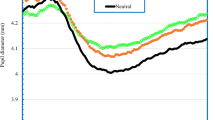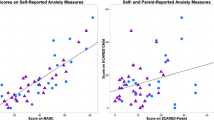Abstract
Thirtysix learning disabled children (21 of whom were also classified as hyperactive) were subgrouped according to teacher ratings of tension-anxiety and conduct problems and then compared on measures of tonic and phasic autonomic arousal. The results indicated that children rated high on the conduct problem dimension evidenced smaller amplitude specific skin conductance responses, and that anxiety appeared to exert a moderating effect on physiological responses. When the hyperactive sample was considered separately, lower skin conductance levels were observed in children rated high on conduct problems than in hyperactive children rated low in conduct problems. These findings support the notion that hyperactive and learning-disabled children are heterogeneous at a physiological level and suggest that physiological differences previously attributed to hyperactivity may actually be correlates of the conduct problem dimension.
Similar content being viewed by others
References
Barkley, R. A. Hyperactivity. In E. J. Mash & L. G. Terdal (Eds.),Behavioral assessment of childhood disorders. New York: Guilford Press, 1981.
Barkley, R. A., & Jackson, T. Hyperkinesis, autonomic nervous system activity and stimulant drug effects.Journal of Child Psychology and Psychiatry, 1977,18, 347–357.
Beckett, A. H. Drug metabolism and kinetics of sympathomimetic amines in man. In A. Cerletti and F. Bove (Eds.),The present status of psychotropic drugs. New York: Excerpta Med. Found., 1969.
Behar, L. B. The preschool behavior questionnaire.Journal of Abnormal Child Psychology, 1977,5, 265–275.
Beiman, I., Israel, E., & Johnson, S. A. During training and posttraining effects of live and taped extended progressive relaxation, self-relaxation, and electromyogram biofeedback.Journal of Consulting and Clinical Psychology, 1978,46, 314–321.
Borkovec, T. D. Autonomic reactivity to sensory stimulation in psychopathic, neurotic, and normal juvenile delinquents.Journal of Consulting and Clinical Psychology, 1970,35, 217–222.
Cantwell, D. P. Psychopharmacologic treatment of the minimal brain dysfunction syndrome. In J. Wiener (Ed.),Psychopharmacology in childhood and adolescence. New York: Basic Books, 1977.
Cantwell, D. P. Hyperactivity and antisocial behavior.Journal of the American Academy of Child Psychology, 1978,17, 252–261.
Cohen, N. J., & Douglas, V. I. Characteristics of the orienting response in hyperactive and normal children.Psychophysiology, 1972,9, 238–245.
Conners, C. K. A teacher rating scale for use in drug studies with children.American Journal of Psychiatry, 1969,127, 884–888.
Conners, C. K. Symptom patterns in hyperkinetic, neurotic, and normal children.Child Development, 1970,41, 667–682.
Conners, C. K. Psychological assessment of children with minimal brain dysfunction.Annals of the New York Academy of Sciences, 1973,205, 283–302.
Conners, C. K. Minimal brain dysfunction and psychopathology in children. In A. Davids (Ed.),Child personality and psychopathology: Current topics (Vol. 2). New York: Wiley, 1975.
Conners, C. K., & Rothschild, G. H. The effect of dextroamphetamine on habituation of peripheral vascular response in children.Journal of Abnormal Child Psychology, 1973,1, 16–25.
Delamater, A. M., Lahey, B. B., & Drake, L. Toward an empirical subclassification of “learning disabilities”: A psychophysiological comparison of “hyperactive” and “nonhyperactive” subgroups.Journal of Abnormal Child Psychology, 1981,9, 65–77.
Doyle, R. B., Anderson, R. P., & Halcomb, C. G. Attention deficits and the effects of visual distraction.Journal of Learning Disabilities, 1976,9, 59–65.
Dykman, R. A., Ackerman, P. T., Clements, S. D., & Peters, J. E. Specific learning disabilities: An attentional deficit syndrome. In H. R. Mykelbust (Ed.),Progress in learning disabilities (Vol. 2). New York: Grune and Stratton, 1971.
Edelberg, R. Electrical properties of the skin, In C. Brown (Ed.),Methods in psychophysiology, Baltimore: Williams and Wilkins, 1967.
Ferguson, H., Simpson, S., & Trites, R. Psychophysiological study of methylphenidate responders and nonresponders. In R. Knights and D. Bakker (Eds.),The neuropsychology of learning disorders. Baltimore: University Park Press, 1976.
Fish, B. The “one-child, one-drug” myth of stimulants and hyperkinesis.Archives of General Psychiatry, 1971,25, 193–203.
Fox, R., & Lippert, W. W. Spontaneous GSR and anxiety level in sociopathic delinquents.Journal of Consulting Psychology, 1963,27, 368.
Hare, R. D.Psychopathy: Theory and research. New York: Wiley, 1970.
Hare, R. D. Psychophysiological studies of psychopathy. In D. C. Fowles (Ed.),Clinical applications of psychophysiology. New York: Columbia University Press, 1975.
Janes, C. L., Hesselbrock, V., & Stern, J. A. Parental psychopathology, age, and race as related to electrodermal activity of children.Psychophysiology, 1978,15, 24–34.
Janes, C. L., Worland, J., & Stern, J. A. Skin potential and vasomotor responsiveness of black and white children.Psychophysiology, 1976,13, 523–527.
Johnson, L., & Landon, M. Eccrine sweat gland activity and racial differences in resting skin conductance.Psychophysiology, 1965,1, 322–329.
Lader, M., & Wing, L.Physiological measures, sedative drugs, and morbid anxiety (Maudsley Monograph No. 14). London: Oxford University Press, 1966.
Lahey, B. B., Green, K. D., & Forehand, R. On the independence of ratings of hyperactivity, conduct problems, and attention deficits in children: A multiple regression analysis.Journal of Consulting and Clinical Psychology, 1980,48, 566–574.
Lahey, B. B., Stempniak, M., Robinson, E. J., & Tyroler, M. J. Hyperactivity and learning disabilities as independent dimensions of child behavior problems.Journal of Abnormal Psychology, 1978,87, 333–340.
Langhorne, J. E., & Loney, J. A four-fold model for subgrouping the hyperkinetic/MBD syndrome.Child Psychiatry and Human Development, 1979,9, 153–159.
Loney, J., Kramer, J., & Milich, R. The hyperkinetic child grows up: Predictors of symptoms, delinquency, and achievement at follow-up. In K. Gadow & J. Loney (Eds.),Psychosocial aspects of drug treatment for hyperactivity. Boulder: Westview Press, 1981.
Loney, J., Langhorne, J. E. & Paternite, C. E. An empirical basis for subgrouping the hyperkinetic/minimal brain dysfunction syndrome.Journal of Abnormal Psychology, 1978,87, 431–441.
Lykken, D., & Venables, P. Direct measurement of skin conductance: A proposal for clarification.Psychophysiology, 1971,8, 656–672.
Montagu, J. D. The hyperkinetic child: A behavioral, electrodermal, and EEG investigation.Developmental Medicine and Child Neurology, 1975,17, 299–305.
Peterson, D. R. Behavior problems of middle childhood.Journal of Consulting Psychology, 1961,25, 205–209.
Prinz, R. J., Connor, P. A., & Wilson, C. C. Hyperactive and aggressive behaviors in childhood: Intertwined dimensions.Journal of Abnormal Child Psychology, 1981,9, 191–202.
Quay, H. C. Psychopathic behavior: Reflections on its nature, origins, and treatment. In I. C. Uzgiris & F. Weizmann (Eds.),The structuring of experience, New York: Plenum Press, 1977.
Quay, H. C. Classification. In H. C. Quay & J. S. Werry (Eds.),Psychopathological disorders of childhood (2nd Ed.). New York: Wiley, 1979.
Rugel, R., & Rosenthal, R. Skin conductance, reaction time, and observational ratings in learning-disabled children.Journal of Abnormal Child Psychology, 1974,2, 183–192.
Sandberg, S. T., Rutter, M., &Taylor, E. Hyperkinetic disorder in psychiatric clinic attenders.Developmental Medicine and Child Neurology, 1978,20, 279–299.
Satterfield, H. J., Atonian, G., Brashears, G. C., Burleigh, A. C, & Dawson, M. E. Electrodermal studies in minimal brain dysfunction children. In C. K. Conners (Ed.),Clinical use of stimulant drugs in children. The Hague: Excerpta Medica, 1974.
Satterfield, J. H., Cantwell, D., Lesser, L. I., & Podosin, R. L. Physiological studies of the hyperkinetic child: I.American Journal of Psychiatry, 1972,128, 1418–1424.
Satterfield, J. H., & Dawson, M. E. Electrodermal correlates of hyperactivity in children.Psychophysiology, 1971,8, 191–197.
Shaffer, D., & Greenhill, L. A critical note on the predictive validity of “the hyperkinetic syndrome.”Journal of Child Psychology and Psychiatry, 1979,20, 61–72.
Siddle, D. A., Nicol, A. R., & Foggitt, R. H. Habituation and over-extinction of the GSR component of the orienting response in antisocial adolescents.British Journal of Social and Clinical Psychology, 1973,12, 303–308.
Spring, C., Greenberg, L., Scott, S., & Hopwood, J. Electrodermal activity in hyperactive boys who are methylphenidate responders.Psychophysiology, 1974,11, 436–442.
Stern, J. A., & Janes, C. L. Personality and psychopathology. In W. F. Prokasy & D. C. Raskin (Eds.),Electrodermal activity in psychological research. New York: Academic Press, 1973.
Stewart, M. S., Pitts, F. N., Craig, A. G., & Dieruf, W. The hyperactive child syndrome.American Journal of Orthopsychiatry, 1966,36, 861–867.
Strother, C. R. Minimal cerebral dysfunction: A historical overview.Annals of the New York Academy of Science, 1973,205, 6–17.
Werry, J. S., Sprague, R. L., & Cohen, M. N. Conners' teacher rating scale for use in drug studies with children: An empirical study.Journal of Abnormal Child Psychology, 1975,3, 217–229.
Zahn, T. P., Abate, F., Little, B. C, & Wender, P. H. Minimal brain dysfunction stimulant drugs, and autonomic nervous system activity.Archives of General Psychiatry, 1975,32, 381–387.
Zahn, T. P., Little, B. C, & Wender, P. H. Pupillary and heart rate reactivity in children with minimal brain dysfunction.Journal of Abnormal Child Psychology, 1978,6, 135–147.
Author information
Authors and Affiliations
Additional information
We wish to express our appreciation to Douglas Carmichael and the teachers of Clarke County for their assistance, to Linda Drake, David Coleman and David Hammer for their technical assistance, to Richard Ulrich and Pat Edwards for assistance in data analyses, and to Keith Conners for his helpful comments in the early stages of this study.
Rights and permissions
About this article
Cite this article
Delamater, A.M., Lahey, B.B. Physiological correlates of conduct problems and anxiety in hyperactive and learning-disabled children. J Abnorm Child Psychol 11, 85–100 (1983). https://doi.org/10.1007/BF00912180
Revised:
Issue Date:
DOI: https://doi.org/10.1007/BF00912180




